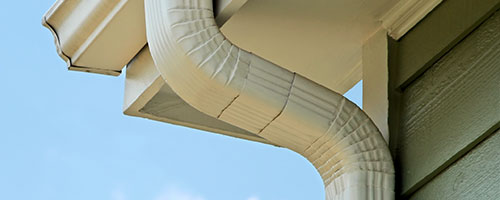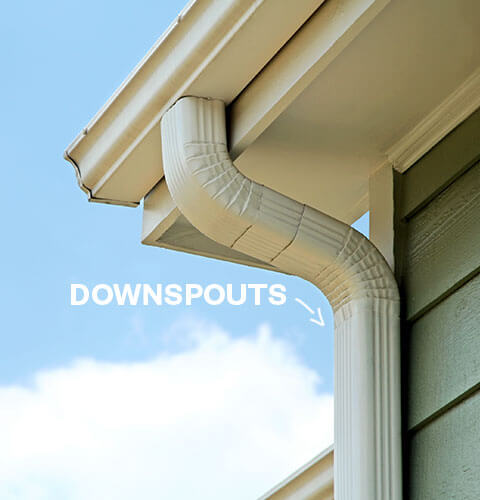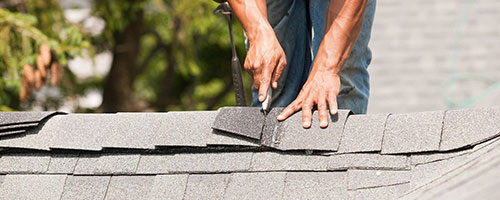Learn about the most common types of roof damage, how to spot them, and what you can do to protect your home from costly repairs.
Continue readingWhat are Eavestroughs and Downspouts?


What are Eavestroughs and Downspouts?
Eavestroughs, also known as gutters, are narrow channels that run along the edge of a roof. They collect and channel rainwater from the roof to the ground, away from the foundation of a building. Downspouts are the vertical pipes or channels that connect to the eavestroughs and carry the collected water to the ground. Together, eavestroughs and downspouts form a rainwater management system that helps protect a building from water damage by directing water away from the structure, preventing water damage to the walls, windows, foundation and surrounding areas, preventing mold growth, mosquito breeding and other issues, preventing water from overflowing during heavy rain and ice damming during winter. These are made from various materials such as aluminum, galvanized steel, copper, and vinyl.
Key Differences:

What are Eavestroughs?
Eavestroughs, also known as gutters, are narrow channels that run along the edge of a roof. They collect and channel rainwater from the roof to the ground, away from the foundation of a building. Eavestroughs are typically made from materials such as aluminum, galvanized steel, copper, and vinyl. They are designed to direct rainwater from the roof into the downspouts, which then channel the water away from the building to prevent water damage to the foundation and surrounding areas. Eavestroughs also play a critical role in preventing mold growth, mosquito breeding and other issues, preventing water from overflowing during heavy rain and ice damming during winter.
Most homeowners may have misconceptions when it comes to how a flat roof can handle the snow. Flat roofs have a low-pitch and so you must have eavestroughs collect the water as it runs down your roof, and safely directs it away from your home. You can also have an interior drain installed, which places a drain in the centre of your roof, connecting to pipes that drain water down through your roof.
Depending on the area of Canada you may live in, the local code is written to include minimum guidelines to handle any intended loads the roof is meant to hold. That accounts for its materials, membrane, insulation and decking. Snow, hailstones and rainfall is considered as well as air conditioners.

What are Downspouts?
Downspouts are the vertical pipes or channels that connect to the eavestroughs and carry the collected water to the ground. They are typically made from materials such as aluminum, galvanized steel, copper, and vinyl, and are designed to channel the rainwater that has been collected by the eavestroughs away from the building. The water is directed to the ground or a drainage system, preventing water damage to the foundation and surrounding areas. Downspouts also help in preventing mold growth, mosquito breeding and other issues, preventing water from overflowing during heavy rain and ice damming during winter. Downspouts are typically placed at regular intervals along the length of the eavestroughs to ensure that the collected water is directed away from the building efficiently.
Eavestrough vs Gutter
Eavestroughs and gutters are terms that are often used interchangeably, but they refer to the same type of component in a building’s rainwater management system. Eavestroughs are the long, narrow channels that run along the edge of a roof, collecting and directing rainwater away from the foundation of a building.
Gutter is another name for the same component, and it refers to the trough or channel that collects and directs rainwater from the roof. Both “eavestrough” and “gutter” refer to the same physical object, which is a channel that is installed along the edge of a roof to collect and direct rainwater away from the building. The terms are used interchangeably depending on the region, context and personal preference.
When to ask for professional help
It is a good idea to hire a professional to check your eavestroughs or gutters at least once a year, preferably before the start of the rainy season, to ensure that they are in good working condition and to address any repairs that may be needed. However, you may want to hire a professional to check your eavestroughs or gutters if you notice any of the following signs:
- Leaks: If you notice water leaking from the eavestroughs or gutters, it may be a sign that they need to be repaired or replaced, and it’s best to have a professional assess the issue.
- Sagging or pulling away from the building: If the eavestroughs or gutters appear to be sagging or pulling away from the building, it may be a sign that they are not properly secured or that the hangers are damaged.
- Clogging: If the eavestroughs or gutters are clogged with leaves, debris, or other materials, it can cause water to overflow or back up, resulting in water damage. A professional will be able to safely remove the debris and ensure that the gutters are properly cleaned.
- Rust or corrosion: If you notice rust or corrosion on the eavestroughs or gutters, it may be a sign that they are not made of durable materials or that they are not properly maintained. A professional will be able to advise on the best course of action.
- Damage: If you notice any holes, cracks or dents on your eavestroughs or gutters it’s a sign that they need to be repaired or replaced. A professional will be able to assess the extent of the damage and provide a repair or replacement plan.
- Ice Damming: During winter, if you notice ice build-up on your eavestroughs or gutters, it may be a sign that they are not properly installed or insulated. A professional will be able to assess the issue and provide a solution.
In general, if you are not comfortable or not able to safely inspect and maintain your eavestroughs or gutters, it is best to hire a professional to do it.

Download our free ebook
To learn more about your home get your free copy of: A Simple, No Fuss Homeowners Guide to Inspecting Your Own Roof
Soffit and Fascia – Why Are They Important For Your Home?


Soffit and Fascia - Why Are They Important For Your Home?
These components are important for protecting your home from the elements. The soffit provides ventilation to the attic, which helps prevent moisture buildup and mold. The fascia helps support the gutter and keep it securely in place, which helps prevent water damage to the home’s foundation and interior.
Both soffit and fascia also play an important role in the overall aesthetic of the home, as they can be made of a variety of materials and come in a range of colors and styles, helping to enhance the overall curb appeal of a home.

What is Soffit?
Pitch and slope are terms used to describe the angles of your home’s roof.
Soffit refers to the underside of an overhang, such as the area under the eaves of a roof. It is typically made of a durable and weather-resistant material, such as aluminum or vinyl, and is used to cover the underside of the roof overhang. Soffit also plays a key role in attic ventilation by allowing air to flow in and out of the attic space, which helps to prevent moisture buildup and mold. Additionally, Soffit can also be used to hide unsightly or underutilized areas of the home and enhance the overall aesthetic of the home.
Slope and pitch create a runoff for snow and rain, if there is not an appropriate slope on your roof there will not be sufficient drainage and can cause roof damages in the future. Snow and rain need to flow into a gutter system and away for the foundation of your home.

What is Fascia?
Fascia refers to the horizontal board that runs along the edge of the roof, where the gutter is attached. It is typically made of wood or composite materials like PVC, aluminum or fiber cement. Fascia serves as a support for the gutter and helps to keep it securely in place, which helps prevent water damage to the home’s foundation and interior. Fascia also helps to protect the rafter tails and eaves from water damage and decay. It also helps to conceal the end of the rafters and give a neat, finished look to the roofline. Like soffit, fascia also plays a role in the overall aesthetic of the home and can be customized to match the home’s style and color scheme.
What Soffit and Fascia materials are the best?
The best material for soffit and fascia depends on the specific needs of your home and personal preference. Some popular options include:
- Aluminum: This is a popular choice for soffit and fascia because it is lightweight, durable, and resistant to rust and rot. It also comes in a wide range of colors and styles, making it easy to match the aesthetic of your home.
- Vinyl: Similar to aluminum, vinyl is lightweight, durable, and resistant to rust and rot. It is also low-maintenance and easy to clean.
- Wood: Wood is a traditional choice for fascia, but it does require regular painting or staining to protect it from the elements.
- Composite materials: Composite materials such as PVC, fiber cement, or composite wood are becoming more popular in recent years. They are durable, low-maintenance, and resistant to rot, decay, and insect infestation. They also come in a wide range of colors and styles.
Ultimately, the best material for soffit and fascia will depend on your budget and the specific needs of your home. It’s a good idea to consult with a professional contractor to determine which material is best for you.

Download our free ebook
To learn more about your home get your free copy of: A Simple, No Fuss Homeowners Guide to Inspecting Your Own Roof
Ultimate Guide for Homeowners on Roof Inspections 2023


Roof Inspections: Ultimate Guide for Homeowners 2023
A roof inspection is an assessment of the condition of a roof, typically performed by a professional inspector or contractor. The inspection is intended to identify any issues or problems with the roof that may need to be repaired or replaced in order to ensure that the roof is functioning properly and to prevent potential leaks or other damage.
The inspection process typically includes a visual examination of the roof’s condition, including the condition of the shingles or other roofing material, the condition of the flashing and seals around penetrations such as vents and skylights, and the condition of the gutters and downspouts. The inspector may also look for signs of water damage, leaks, or other potential problems. They may also use tools such as binoculars or a moisture meter to aid in the inspection.
It’s recommended to have a regular inspection schedule, in general, it is recommended to inspect new roofs within the first year, and then every 3-5 years after that. For older roofs, it’s recommend to do it every 3-5 years, but if the roof is nearing the end of its expected lifespan, or if there are visible signs of wear and tear, it’s recommended to inspect it more frequently, ideally every 1-2 years. In case of an area with harsh weather conditions or a history of severe storms, you should inspect it right after such event.
It’s important to hire a certified and experienced inspector, for example, Haag Engineering provides training and certification for roof inspectors. They will produce an inspection report containing all the information gathered during the inspection, including the details of any damage found and recommendations for repairs or replacement if necessary.
Regular roof inspections can help you to maintain the value of your home, keep it protected from the elements, and help you to identify and prevent potential problems early on.
The inspection process typically includes a visual examination of the roof’s condition, including the condition of the shingles or other roofing material, the condition of the flashing and seals around penetrations such as vents and skylights, and the condition of the gutters and downspouts. The inspector may also look for signs of water damage, leaks, or other potential problems. They may also use tools such as binoculars or a moisture meter to aid in the inspection.
It’s recommended to have a regular inspection schedule, in general, it is recommended to inspect new roofs within the first year, and then every 3-5 years after that. For older roofs, it’s recommend to do it every 3-5 years, but if the roof is nearing the end of its expected lifespan, or if there are visible signs of wear and tear, it’s recommended to inspect it more frequently, ideally every 1-2 years. In case of an area with harsh weather conditions or a history of severe storms, you should inspect it right after such event.
It’s important to hire a certified and experienced inspector, for example, Haag Engineering provides training and certification for roof inspectors. They will produce an inspection report containing all the information gathered during the inspection, including the details of any damage found and recommendations for repairs or replacement if necessary.
Regular roof inspections can help you to maintain the value of your home, keep it protected from the elements, and help you to identify and prevent potential problems early on.
signs that you are ready for a roof inspectiton
Here are some signs that it may be time for you to schedule a roof inspection:
- Age of the roof: If your roof is approaching the end of its expected lifespan, it’s a good idea to schedule an inspection to see if it needs to be repaired or replaced.
- Visible damage: If you notice missing or damaged shingles, cracked or missing flashing, or other signs of damage on the roof, it’s a good idea to schedule an inspection to determine the extent of the damage and what repairs may be needed.
- Leaks or water damage: If you notice water stains on your ceiling or walls, or if you have experienced leaks in your home, it’s a good idea to schedule an inspection to determine the source of the problem and what repairs may be needed to prevent future leaks.
- Sagging or uneven areas: If you notice that your roof is sagging in certain areas or that it appears to be uneven, it’s a good idea to schedule an inspection to determine the cause of the problem and what repairs may be needed.
Homeowner Inspections vs. Professional Inspections
Homeowner inspections and professional inspections are two different types of roof inspections that serve different purposes.
Homeowner inspections: These types of inspections are typically done by the homeowner themselves, and they are intended to identify any obvious problems with the roof that may be visible from the ground. They usually involve a visual examination of the roof’s condition, looking for missing or damaged shingles, cracks in flashing, or other signs of damage. Homeowner inspections can be a useful way for homeowners to identify obvious issues with their roof and get a general sense of the condition of their roof, however, these types of inspections do not provide a detailed and thorough examination of the roof’s condition.
Professional Inspections: Professional inspections are conducted by certified and experienced inspectors, who are trained to identify and assess issues on the roof that may not be obvious to homeowners. They use specific tools and equipment to evaluate the condition of the roof and they also have knowledge of proper standards and regulations. They will produce an inspection report which contains all the information gathered during the inspection, including the details of any damage found and recommendations for repairs or replacement if necessary. They will also often have a liability insurance that covers any potential damages caused by their work.
While a homeowner inspection can give you a general idea of the condition of your roof, a professional inspection is a more detailed and accurate assessment of your roof’s condition, and will give you a better understanding of any potential problems, repairs or replacements that may be needed.
What to Expect from Professional Roof Inspections
When you schedule a professional roof inspection, you can expect the inspector to thoroughly evaluate the condition of your roof. Here is a general overview of what you can expect from a professional roof inspection:
- Pre-inspection consultation: Before the inspection, the inspector will schedule a pre-inspection consultation with the homeowner to discuss any concerns and focus areas of the roof
- Safety equipment: The inspector will use necessary safety equipment and will take necessary precautions to ensure the safety of themselves and others while on the roof.
- A thorough visual inspection of the roof: The inspector will check for damage, leaks, and other issues. They will pay attention to the condition of the shingles or other roofing material, flashing and seals around penetrations, gutters and downspouts
- Using specialized tools: They may use specialized tools such as binoculars, moisture meter or infrared cameras to aid in the inspection
- Detailed report: After the inspection, the inspector will produce a detailed report that highlights the findings, any issues found, and recommendations for repairs or replacement if necessary.
- Suggesting solutions: Inspectors usually offer solutions for the issues found, so that the homeowner has a clear understanding of what needs to be done.
- Following standards: Inspectors who are certified by organizations such as Haag Engineering will follow specific guidelines and standards
- Professional liability: Professional inspectors may have liability insurance that covers any potential damages caused by their work, giving the homeowner an extra peace of mind.

Download our free ebook
To learn more about your home get your free copy of: A Simple, No Fuss Homeowners Guide to Inspecting Your Own Roof
How Much Does it Cost to Replace a Roof in Calgary? 2023


How Much Does it Cost to Replace a Roof in Calgary?
The cost to replace a roof in Calgary can vary widely depending on a number of factors, such as the size of the roof, the materials used, and the complexity of the job. On average, however, homeowners can expect to pay between around $9,000 to $50,000 or more for a new roof.
The cost of a basic asphalt shingle roof can average $12,000. If your roof is particularly steep or has a complex layout, or if you have to remove and dispose of an old roof first, it will cost more.
It is important to keep in mind that, it always better to have professional come and take a look, give you a detailed estimate, and recommend the best materials for your home and budget.
Also, It is important to note that prices may vary depending on the actual condition of the roof, complexity of the work, and the specific location in Calgary.
Factors That Impact The Cost of A Calgary Roof Replacement
There are several factors that can impact the cost of a roof replacement in Calgary. Some of the most significant factors include:
1. Roof size
The larger the roof, the more materials and labor will be required to complete the job, which will drive up the cost.
2. Materials
The type of material used for the roof can have a big impact on the cost. Asphalt shingles are the most common and affordable option, while metal or clay tile roofs are more expensive.
3. Pitch of the Roof
The pitch of the roof, or the steepness of the slope, can impact the cost of a roof replacement. Steeper roofs are more difficult to work on and require more labor, which can drive up the cost.
4. Accessibility
The accessibility of the roof can also impact the cost. If the roof is difficult to reach or if there are any obstacles that make it hard to work on, it can add to the cost of labor.
5. Tear-Off and Disposal
If an old roof needs to be removed and disposed of before a new one can be installed, this will add to the overall cost.
6. Professional/Contractor
Like any other service, the experience and reputation of the contractor can also play a role in determining the final cost.
7. Custom Work
Additional requirements such as special ventilation, custom flashing or skylights will add more costs to the overall project.
What To Look For In A Roofing Company

Download our free ebook
To learn more about your home get your free copy of: A Simple, No Fuss Homeowners Guide to Inspecting Your Own Roof
